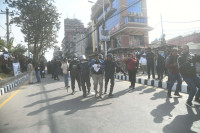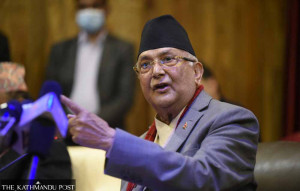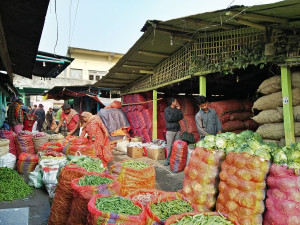Editorial
Lost in translation
The people deserve more essential health services, and the government must clarify and publicise what’s available..jpg&w=900&height=601)
Nepal currently faces threats from multiple directions. The SARS-CoV-2 crisis, with positive cases rising regularly, and the socio-economic effects of the consequent lockdown, with the loss of income and mass reverse migration being experienced, continue to wreak havoc with people’s lives. As if this wasn’t bad enough, the country is also experiencing a measles outbreak at the same time. And, to add to the hardship, reports suggest that there has been a sharp decline in the number of expectant mothers availing of maternal health services, at great risk to themselves and their unborn children.
The issue here is definitely not willful disregard of available programmes by needful patients. The issue, as in the case of most services during the country-wide lockdown, is the lack of information and planning by the government at various levels. While the decreased mobility of people could have afforded the government to ramp up immunisation drives and provide other specialised services in a safe manner, concerned agencies have spectacularly failed to use the opportunity. What is worse, with the government being unclear on the services that people can avail of, the people are deprived of even much-needed actions.
The reduced number of expectant mothers going to healthcare providers is a case in point. Nepal had, in the past, made significant strides in its attempts to curb infant and maternal mortality rates. In fact, for its spectacular reduction of the maternal mortality rate in the decade between 1996 and 2006, by 50 percent no less, Nepal won a Millenium Development Goals Country Award in 2010. However, even before the Covid-19 crisis, the country had been unable to match this performance. Over 2,000 newborns and 208 new mothers died due to childbirth-related issues in the fiscal year 2018-19 alone. What’s worse, these numbers account for the registered deaths in state-run health facilities alone.
Now, as the lockdown continues well over 30 days, expectant mothers have been unable to visit healthcare facilities for crucial antenatal checkups that usually catch complications in time to save mothers and babies. About a quarter of maternal deaths occur during or right after childbirth. Since many pregnant women are situated in areas with lower access to transportation, and with the current situation reducing previously available transportation, many women are being forced to deliver at home in unsafe and unpredictable conditions. Information on how pregnant women and new mothers can avail of life-saving services, medicines and supplements are severely lacking.
Another current health crisis, as health facilities reduce their services, has been a growing concern with measles. A deadly disease that killed 140,000 people in 2018 alone, measles has already killed at least two in Dhading this year. Nepal was already in danger of being run over by a measles outbreak in February, owing to what was most likely false reporting of immunisation success. Now, the disease has spread from the epicentre in Dhading to Kathmandu and Lalitpur districts. It is baffling that measles has continued to spread even during a lockdown. But what is truly worrisome is the reduced immunisation and treatment facilities during the lockdown will surely worsen the situation.
The common theme in these two health emergencies, along with the continued increase of novel coronavirus cases, seems to be the government’s failure in service and information delivery. Measles, for example, has been as deadly a disease to Nepal as Covid-19 has been to the world: the government should have included its prevention and treatment to the current containment efforts. Moreover, while it is understandable that services cannot run normally during an infectious pandemic, maternal health services should have been prioritised, with transportation or mobile diagnostics prepared in all districts to ensure mother and child safety. And, while officials at the Family Welfare Division have mentioned the set up of a free maternal health hotline, there is no information at all on when this pressing need will be fulfilled. The governments at different levels must coordinate more effectively, and information on essential services available must be vocalised through mass transmission systems.




 12.12°C Kathmandu
12.12°C Kathmandu














